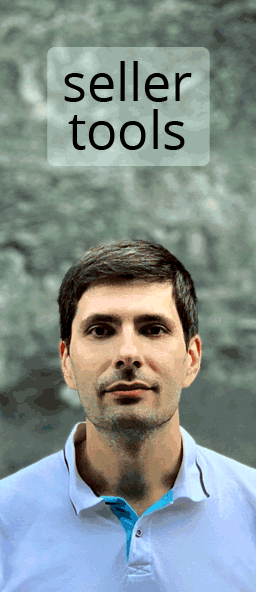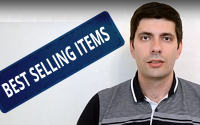If you think you have what it takes to make money on eBay, you're probably right. There is no mystery behind it, and it's not something only talented people can do. I firmly believe anyone can make this business work if only they have the will to work hard and smart. This complete guide will show you how to make money on eBay and the included tips will set you on the right path.
Sign up with eBay and buy a few things first
When you sign up with eBay you'll notice it's free and simple to do. You'll go through a series of questions and forms to fill in, and the whole process won't take you longer than 15 minutes.
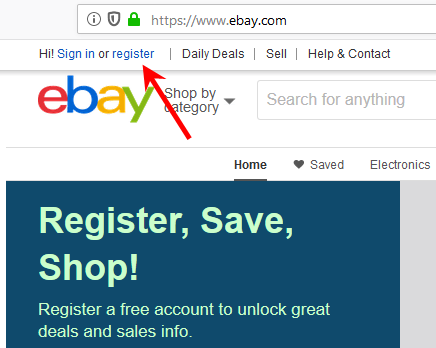
The whole point of buying some things from the eBay marketplace is this: you'll learn so much along the way. When you make a purchase or win an auction, you'll see how all the notifications work, how payments flow from the buyer to eBay and the seller. A package will arrive at your doorstep, and this will give you a first-hand look at how a real eBay seller is making shipments.
There are so many little details you'll pick up on, that it's impossible to go through them all in this article.
The experience that you gain will be invaluable for you when you start listing items for sale. As you make those listings, and eventually when you make sales, you'll also know what the buyers expect from you. Therefore, you'll be much less likely to make mistakes.
Use PayPal for making and accepting payments
After you set up your eBay account, we recommend that you also register with PayPal, and relate your two accounts together.
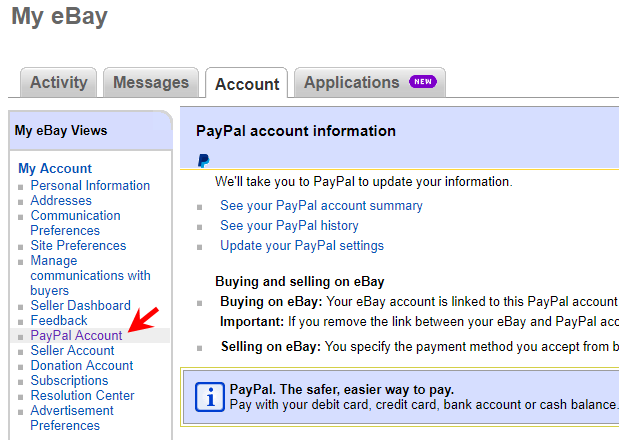
Like with using eBay, when you use PayPal to make a purchase, you will be gaining valuable experience as a buyer. More importantly, you will have your account set up and ready to accept payments too! Not many people write about this, but PayPal is still the most trusted payment provider on the eBay platform. In fact, if you don't use PayPal, you'll be in a weird position where no one will want to buy from you.
So, just set it up. It will be a longer process than with eBay, but it's a one-time task for you to configure PayPal with your bank accounts and credit cards. Once you have this done, you can begin to sell on eBay! Congratulations!
How to price your items on eBay
There are two ways to price your items on eBay, and both of them involve research:
- Use eBay completed & sold listings filters, and look for average prices
- Use our keyword research tools to see average item prices
Another critical factor in listing pricing is your feedback history. If you're a newbie, I'm sorry, but your sales prices will tend to be lower than average! This is just a part of life, and the main reason for this is you haven't earned trust from buyers yet. Once you have a solid feedback profile, you'll do much better.
Depending on your listing format choice, you have two choices. If you have a fixed price listing, then just use the average sales price as your "buy it now" price. If you use the auction format, it's a good idea to reduce your starting price, and if you're really worried then set up a reserve price.
Know your PayPal and eBay selling fees
We created an eBay fees calculator for you, which you can use to see what your fees will be before you make a listing. For a full eBay fees overview, please visit the seller fees page.
In general, when I have to calculate my fees in my head, I use a total of 15%, because:
- eBay will take 10% as their final value fee.
- PayPal will normally take 3.5% in processing fees.
- I might use somewhere around 1.5% in listing promotions for my buy-it-now items.
So, 15% covers all of these things. But it doesn't cover potential extra shipping costs that I have to cover, and packaging costs aren't considered at all.
As a beginner, you're probably better off if you round up your selling fees up to 20%. And as you sell, you'll learn more about your actual fees and real costs.
It also depends on where you live. For instance, people living in the UK have to pay an extra VAT fee on their eBay fees, and this something US sellers don't have to deal with.
While I use a 15% estimate for myself, I recommend you use a 20% estimate for your eBay business fees when you start.
Writing your eBay listing description
Writing a good eBay listing description is actually very simple to do, and here are some quick points that you should follow:
- Don't make it too long and not too short (100-300 words)
- Don't center everything, use left-align
- Highlight the most important parts in bold, like in this article
- Use lists (for example to list item attributes)
As you write more and more descriptions, you'll realize that you end up rewriting some parts over and over, and that's why we recommend that you maintain a template for yourself.
Specifically, you'll usually be writing the same shipping and returns policy over and over. Having this as a copy/paste option will help you write listing descriptions faster in the future.
Take good photos of your items
The best size for eBay photos is 1600x1600 pixels, which is a 1:1 square aspect ratio. We have done a study on the topic of best eBay photos, and you are welcome to check the results. Make sure your photos are clear and show the item in full. The most basic eBay photo guidelines to follow are:
- Don't add borders or frames
- No text in your photos
- No watermarks
- The main photo should show the whole item
- Don't add yourself in the photos, just the product. For example, no selfies allowed!
If you follow these simple rules, you should be just fine.
However, I will add that "beautiful" photos do sell better!
For example, if you're selling picture frames, then a picture of the frame on a sandy beach with a blurred ocean background will work way better than the same item on sitting your desk. Do spend some time browsing the sold items lists on eBay, and you'll start to get a feeling for how pictures alone can make or break a sale.
These days, a good smartphone will have the function to give you a blurred background in your pictures, so this technology is available to everyone.
Auction or Buy It Now (Fixed Price) eBay listing format?
When you make your very first listings on eBay, we recommend that you start with Buy It Now (Fixed Price) listings, because auctions will not really work for you at first. With a non-existing feedback profile, buyers will not trust you enough to place bids on your items, and you will usually end up with an unsold item, or just one bid.
So, make some fixed price listings, and use the eBay listing promotions feature to get some visitors. As the days go on, lower your price by just a tiny bit, and eventually you'll make your first sale.
On the other hand, if you're an established seller, with a lot of positive feedback, then auctions can easily be your best bet!
Every day, I see a lot of seasoned sellers put up expensive phones with a starting bid of just $1, and they get a frenzy of bidders one-upping each other. This is a great strategy and 7 days later a sale is definitely made. Often at a premium price too, because buyers will often outbid each other just to win!
Using eBay listing promotions to get more viewers
When you make a Fixed Price (or buy it now) listings, you will get the option to promote your listings. This option is all the way at the end of your listing setup page:

Most of the time, eBay will recommend that you use 7% here. And this is a lot...
I like to change this number to 1.5% because I find the results tend to be the same. eBay will run recommendations of your listing across the whole platform, and it's only a matter of how much additional exposure you want. For my listings, giving eBay a small amount does the job really well, and those listings get an obvious boost.
You're free to not use this feature too, and you're welcome to experiment both ways here. I am just sharing my experience that 1.5% is the best option for my listings.
Timing of your listing does make a difference
We have done a research study on the best days and hours to end your eBay listing. When timing your listing, the best days to end your eBay sale are in the following order:
- Sunday 6:30 pm PST
- Monday
- Saturday
- Tuesday
- Thursday
- Friday
- Wednesday
However, I highly recommend checking our full study on this, because there are many nuances. For example, on Monday and Wednesday nights, sales prices tend to spike up while sales volumes drop. You can use this knowledge to auction off high demand items at a premium.
How to ship on eBay
Shipping your very first eBay item is exciting! You'll get an email notification telling you the destination address. Print this and take it with you to the post office. We recommend using the USPS instead of FedEx or UPS because it's so much cheaper and the delivery speeds are not too bad.
Once at the post office, get yourself a shipping package or box depending on your item, and fill in both your and the buyer's addresses. Hand it to the clerk and tell them what's inside the package, because sometimes it makes a difference. For example, if it's a book or DVD movie, then you should get a cheaper media rate.
Make sure you get a tracking number or proof of postage!
Go on your eBay sold items list, and enter the tracking number into the system, and you're done. The buyer will get a notification that you sent out the package. Also, eBay will do tracking for you.
As you do this more and more, you'll start to find ways to do things faster. For instance, you can print shipping labels at home. You can also get your packaging supplies in advance, and pack products in advance. All these tricks will save time, and make you more productive.
Your eBay feedback is king
When you start to make some sales on eBay take very good care of your first customers. They will reward you with your initial positive reviews, which will help you make more sales later. It's no wonder your eBay feedback profile is so important for your business.
Be polite in your messages, and follow all the eBay communication rules. Ship your items fast, include thank-you cards, and you'll be on your way to success.
The flip side of this is, make sure you never get negative feedback! If a buyer has a complaint, listen to them. Do everything in your power to make sure an argument doesn't escalate to moderators at eBay. In 99% of the cases, they will side with the buyer anyway, so you may as well do this yourself.
Here's what I tend to do when there's a conflict (which is rare too!). If a buyer wants a refund, I just give it to them as long as they return the item. I'll even pay for the return postage. Sure, I'll be losing money, but I'll make it up soon enough from other sales.
If the buyer wants a partial refund - I never give it to them! Instead, I politely offer a full refund if they mail the item back to me. This does several critical things:
- If the buyer was trying to scam me, they now have to decide to drop the scam or escalate to eBay - but I offered a full refund, so they don't have much of a case against me!
- If eBay is watching me, they will appreciate that I'm trying to resolve the issue without involving them, it just helps their business
And sure, sometimes you do end up making a small loss with this communication strategy, but at least you should be safe from negative feedback.
Use eBay's function to send offers to listing watchers
When you make Fixed Price listings, you'll normally get people signing up as watchers. There's now a feature available that lets you send an offer to eBay watchers. We've used this strategy quite a lot to make some quick sales.
When you send an offer, you'll have to provide at least a 5% discount. So, please do this only for those listings which you can afford to lose a bit of income. With that being said, it is a new way to connect with buyers, and there's no reason to skip this function entirely. Every tool has its place, and this is one of them.
Just keep in mind that when you send an offer to a buyer, your offer is binding and the buyer will have a whole 48 hours to accept.
Research eBay sales data
Researching eBay sales is the one thing sellers don't like to do, and ironically it's also the one action that can put you ahead of your competition. We offer research tools on our home page, and free research tools if you register. So there's no excuse and no reason you should not do this.
The data we provide will include things like price trends, keywords to use in your titles to help you get more sales, and even entire lists of products that are selling very well on eBay right now!
Sell-through and average prices are also part of our tools.
Another way to do your research is to look for eBay sold items, and study those listings directly. However, you'll have a hard time grasping all of that information, and that is why we created our own tools.
Finding products to sell
The absolute best place to start is to look in your own home for products or items you don't need anymore. We recommend this for everyone who is just starting on eBay. Our short guide on items you probably already have will help you.
Only after you've gained experience selling stuff you already have, should you even try looking for more items out of your comfort zone. We recommend visiting garage sales, store closing sales and Goodwill for some new ideas. Do this early in the morning, because you have competitors you don't know about. That's right, eBay is so big, that even your local town probably has a hundred other eBayers.
Remember, you don't have to buy things right away, you're just checking things out, and looking for opportunities. Take your smartphone with you, so that you can check prices on eBay as you go. (Watch others doing the same!)
When you think you've got something interesting, go ahead and buy it, but don't go crazy here. You should take this slowly and you'll make mistakes along the way. Just make sure you learn from them, and you'll do just fine.
Seller tips for how to make money on eBay
It's never too late to start your business and make money on eBay. In fact, right now is the best time ever, because this market has never been bigger! If you're seriously going to give eBay a good try, then these tips and tricks will help you get started to making a side income:
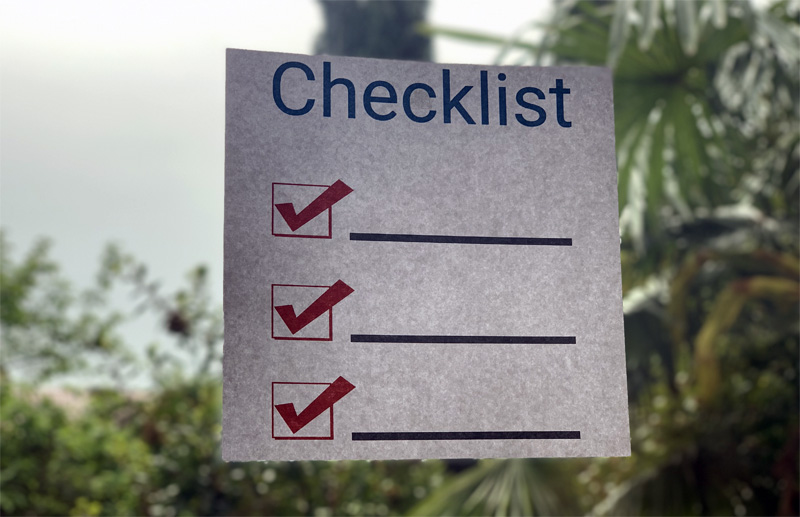
Sell inexpensive items in the beginning
You'll be tempted to list your expensive things in the hopes of making some big bucks. But this is a mistake to avoid! Here's the simple reason that's just part of reality, and you won't hear this anywhere else: new eBay sellers often get scammed and always get low-ball prices. Don't believe me? [LINK] Here's a link to recently sold iPhones on eBay - check it out. As you go through the list, notice how everyone with a low feedback number (under 50) sold their smartphone at a much lower price than more established sellers. Don't be one of these sellers!
When you start, sell items that are less than $100 each. You'll be doing yourself so many favors this way.
First, scammers won't be too interested in you, because even if they win, they'll only earn a little money, and they have more interesting sellers to attack.
Second, honest buyers will be more willing to work with you even though you have no positive feedback yet. After all, they're not risking a lot.
Third, you will be able to do many more nominal sales with cheap items, and you'll grow your feedback profile fast.
Have a listing strategy
This is the one tip that I don't see any information about online, so bear with me here. Very often I have more than one of the same or similar item. To be specific, one of the niche items that I sell on eBay is sea glass. And after spending time on the beach with my family, I have a lot of it collected. And this is the perfect example to describe my listing strategy, because I came to it only through trial and error, and I made lots of mistakes.
At first, I was spending a lot of time making all kinds of listings, thinking the more I list the more I'll sell. But this turned out to be wrong. I forgot to listen to the market! Sure, some sales were going through, but nothing major. I then changed my strategy, and I made only about 15 listings and deleted all the dead listings that were going nowhere. When an item sold, I would go back to my collected batch and relist the same listing with new pictures. This approach changed everything for me, and it was a big lesson too.
Don't make tons of listings, instead focus on your listing quality, and listen to what buyers are telling you when they make a purchase or send an offer. As your eBay business grows, you will run into the same thing, and that's why having a listing strategy is important.
Watch your income and expenses closely
Every so often, calculate your income and expenses. Add up all your eBay sales, and subtract your shipping costs, eBay fees, and inventory costs. The result is your total earnings for the period. I like to do this at the end of every month. You might be thinking, that this is obvious and you were going to do this anyway. But let me explain one thing here.
While you do these calculations, you will certainly begin to notice some critical things:
- Which listings are selling more than others?
- Which listings are bringing more profit than others?
As you monitor your sales, expenses, and profits, you will also know the answer to the above questions. And you will know which products are worth investing in, and which you should quit selling. If there's one thing you have to know to do on eBay (and generally in life), is this: double down on things that work, and stop doing what doesn't work.
Always send thank you notes to buyers
When buyers get a "Thank You" note from you, you will already be head and shoulders above most of your competition. This is especially true for big eBay businesses, which often have no time to do this! It's a small token of appreciation and your customers will be more likely to remember to leave you positive feedback.
Yes, guilting your customers into leaving you feedback is allowed on eBay, as long as you don't ask for it directly!
Beyond this, you can send a message such as "Did the item arrive in good shape? Is it like you expected?". Again, you're showing good intentions and as long as you're sincere, then your customers will not only like you, but they'll return for more business in the future!
Ship your items quickly
When your listings sell, make sure you ship as soon as possible. Preferably even on the same day. Put yourself in the buyer's shoes - they came to your store, trusted you enough to make a purchase or win your auction, and already paid you. So don't delay with shipping.
When you ship, just make sure you pack your item securely and get a tracking number (or proof of postage). In your eBay seller account, you will be able to enter this tracking number into your sold listing details, and eBay will even track the shipment for you. The buyer will be notified about this, and they'll be very happy and relieved that you sent out the package. It's all just basic courtesy and good customer service.
Make sure your seller feedback is all positive
The eBay feedback profile is the key metric separating new sellers and big sellers. Please take all reasonable steps to get positive feedback from your first sales. Here are some basic things you should do:
- Pack your item well.
- Ship your product fast, and with tracking.
- Include a thank you note to the buyer.
- Leave positive feedback to the buyer.
This doesn't take a lot of effort. From my experience, you'll still only get maybe 1 out of 5 buyers to leave positive feedback, and that's normal. Still, it doesn't mean you should give up, quite the opposite. The more you interact with your buyers, the better, and through good interactions, you'll be earning your feedback and good relations too.
Manage your time
Maintain some sort of a timesheet of how much time you spent on which tasks. As you do this, you'll have the possibility to do some interesting calculations and decisions:
How much do you earn per hour from your eBay business? This is only possible if you know how much time you spent.
Which tasks do you have to improve on? Very often, writing descriptions is something eBay sellers struggle with and spend too much time on perfecting. If you're one of them, make yourself a template or use our free eBay listing template. Make sure your time is spent as productively as possible because your competitors are doing the same!
Like in my example above with my niche products, I was definitely spending too much time on making those listings. Looking back, it was probably over 50 hours
Go to closeout sales and yard sales
Once you've made some initial sales and got to know the platform, it's time to look for items that you can sell on eBay on a more consistent basis. And the best places to source your starter products are these three:
- Yard sales.
- Store closeout sales.
- Thrift stores.
You don't have to spend a fortune here (in fact don't!). But do go out there, and spend a Saturday to collect new inventory and list it on eBay. Markets are never perfect, and you can make money with price arbitrage. It will be a new learning experience, and you're likely to run into other eBayers along the way. It's a small world! The most important skills you'll be practicing here are negotiation and potential profit calculations. Take your smartphone with you so that you can do item research on the fly. These might seem like mundane skills, but they are very relevant in the real world.
Always be looking out for trends
When you start to make some sales on eBay, and you start to have some growth, it's important to keep an eye out for new trends in the category you're listing in.
For example, if you're into selling clothing, you have to watch for fashion directions.
If you're into electronics, look out for new gadgets.
If you're selling bound handmade books, stay sharp with the latest techniques and color balances.
That's all because of one very simple principle. In the modern world, things change so quickly in all aspects of our lives, that if you do not stay on top of such market trends, then you will very quickly be listing irrelevant products. Likewise, the market will reward you with good income if you offer the right product! So, maximize your chance for success by studying what your buyers want.
All big sellers were once small
It's easy to be intimidated by the major eBay sellers out there, but don't be! Remember, everyone had a starting point and everyone was just like you. This means you can become a big seller, and you are limited only by yourself.
Over the years, we've tracked millions of top rated eBay sellers. And you know what? They come and go real fast. Most of them will be replaced by newcomers into the field in just a few years. And all this means that it's never too late to start building an eBay business, and if you're persistent enough, you will surely succeed.
Can I sell internationally on eBay?
You can absolutely sell internationally on eBay, and this is a very easy way to grow your eBay sales. eBay has what they call the global shipping program to help you do this. By default, if you're located in the US and you list on the eBay.com website, your account is already part of this program and you don't have to do anything else.
There are no additional fees to pay for you as a seller, and eBay will take care of shipping your item internationally as well as customs processing. You'll only be required to send your packages to an eBay processing center when an international buyer makes a purchase.
Look for niche products to sell on eBay
Once you've got the experience of first selling your own things, and then by reselling other items you found at a garage sale or Goodwill store, you are ready to start studying the broader market. As you do this research, the idea is to look for what I call "holes" in the demand and supply of a particular product. Using our niche research tools is especially helpful for this task.
The most important thing to research at first is, make sure the demand exists. If the demand simply isn't there for your niche product idea, then you're risking so much and you don't realize it.
After verifying the demand, look at the individual eBay listings that are fulfilling that demand. Always think - how can you do better? I have some tips here, to get your brainstorming going:
- Can you combine 2 products to sell them in a new and meaningful way? For example, in the DIY electronics retail business, you'll often see listings that include an electronics board, a book about that board, power cords all combined. In the telescope sales business, you can find people selling a telescope, combined with different lenses.
- What are the buyers really trying to solve with the item you're checking? And can you help to solve that better? Here's a cool example: you'll find many pasta drying racks on eBay. And while all of them will dry pasta, none of them will teach the buyer on how to do it. Including a book on the topic will go a long way.
This should give you a good start to figuring out your niche products, and this will be where your truly serious earnings come from. Have fun making money on eBay!




